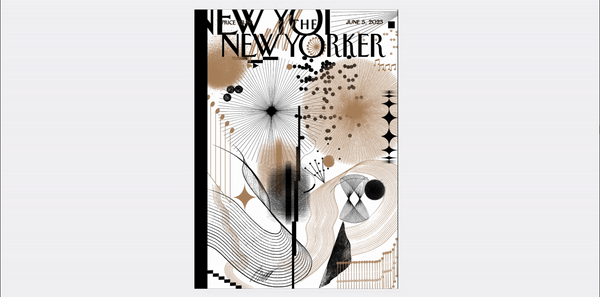

t’s not often that the cover of The New Yorker, traditionally a storytelling image signed by the artist, reflects what goes on behind the scenes at the magazine—but that is what the black and copper shapes designed by Masha Titova for the cover of the June 5, 2023, Music Issue, available to read in its entirety here, manage to do.
The first step was connecting with Titova, a Russian artist who relocated to Montenegro last year, after the Russian invasion of Ukraine. I asked Titova to use her sense of design to orchestrate a portrayal of a variety of sounds. Titova says, “I don’t play an instrument, but I love music, especially its rhythms, which often inspire me. And when I design, I try to harmonize the various visual shapes as if they were part of a musical composition.”
Once we settled upon the image, we recorded the aural elements that make up the cover’s malleable melody. Some of our more musically adept staffers—including Nick Trautwein, a senior editor who moonlights as a saxophonist, and David Remnick, the editor, on guitar—gathered to interpret Titova’s shapes, selecting the ones they wished to play. Julia Rothchild, a managing editor, who contributed piano, viola, and voice, described the process as “an exercise in synesthesia. What sound would that square make, or those triangles? A thud, or a flutter?”
Impromptu chamber groups formed: a viola-cello duo, a vocal quintet. The musical respite in the middle of the day presented the opportunity to exercise a different kind of focus from that of closing pieces, or making fact-checking calls. The associate research director Hélène Werner, who has played the cello since she was eight years old, said, “Music set me on my way. It was the organizing principle of my childhood. . . . It demands, of those who play it and listen to it, intellectual commitment and emotional honesty. It is generous in return. There is no better teacher.” Rina Kushnir, the art director, also appreciates music for its emotive qualities, for its ability to communicate what is “not possible to express otherwise.” Liz Maynes-Aminzade, the puzzles-and-games editor, says that “drumming and writing (puzzles or otherwise) light up some of the same parts of my brain.” A unifying factor in everyone’s performance was how seriously each performer took their music. One after the other, when their turn came, they paused their casual banter, took a deep breath, played their bit, and only then rejoined the playful green-room atmosphere. It was an unplanned but perfect demonstration of all our colleagues’ marvellous dedication to all they do.
The making of a weekly magazine (or of a Web site, a radio show, a festival, any of our many undertakings) is always a concerted endeavor, but that collaboration happens behind the scenes. This multimedia project, programmed by David Kofahl, the head of the interactives department, with the help of the features editor Sam Wolson, gives a glimpse of the way the efforts of many talented individuals and departments combine to insure that The New Yorker appears on your doorstep (or in your in-box), week after week, as good as we can make it.
See below for more covers about music:
Find covers, cartoons, and more at the Condé Nast Store.
Masha Titova’s “The Music of Art”
Source: News Flash Trending





0 Comments